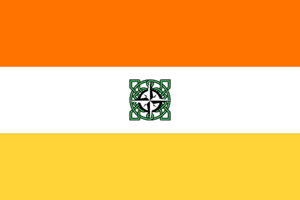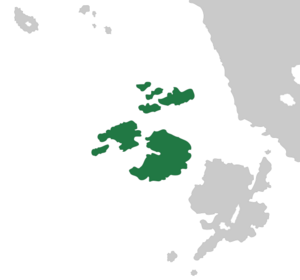New Ardmore: Difference between revisions
m (→Government) |
|||
| Line 75: | Line 75: | ||
! style="vertical-align:bottom; text-align:center;"| First Elected | ! style="vertical-align:bottom; text-align:center;"| First Elected | ||
|- | |- | ||
| style="background-color: | | style="background-color:#FFA500" | | ||
| Angus MacIntyre | | Angus MacIntyre | ||
| style="text-align:center;" | Fíanna Aird Mor ([[Kiravia of Regions|KR]]) | | style="text-align:center;" | Fíanna Aird Mor ([[Kiravia of Regions|KR]]) | ||
| style="text-align:center;" | 21201 | | style="text-align:center;" | 21201 | ||
|- | |- | ||
| style="background-color: | | style="background-color:#FFA500" | | ||
| Séamus | | Séamus mac Dómhnaill | ||
| style="text-align:center;" | Fíanna Aird Mor ([[Kiravia of Regions|KR]]) | | style="text-align:center;" | Fíanna Aird Mor ([[Kiravia of Regions|KR]]) | ||
| style="text-align:center;" | 21201 | | style="text-align:center;" | 21201 | ||
|- | |- | ||
| style="background-color: | | style="background-color:#44532A" | | ||
| Tomás Ó Flaithbertaigh | | Tomás Ó Flaithbertaigh | ||
| style="text-align:center;" | Aontú ([[Caritist Social Union|CSU]]) | | style="text-align:center;" | Aontú ([[Caritist Social Union|CSU]]) | ||
Revision as of 23:22, 9 June 2024
This page is currently undergoing major reconstruction in accordance with broader lore changes. |
| Free State of New Ardmore Saorstát Aird Mhóir Nua (Gaelic) Helviārka Inox Ardmór (Coscivian) | |
 Flag | |

| |
| Sovereignty | |
| Theme | |
| Capital | Dundalk |
| Largest City | Rosmore |
| Population | 6,531,159 |
| Ceann Stáit | Màrtain MacBharrais (FAM) |
| Tánaiste | Fionnghal NicDhòmhnaill (FAM) |
| Stanora seats | 3 |
| Official languages | Garán Gaelic |
| Postal Abbreviation | ARD |
New Ardmore (Gaelic: Ardmór Nua, Kiravic: Inoardmór) is an overseas region of the Kiravian Collectivity comprising an archipelago in the Odoneru Ocean. Laying off the coast of mainland Levantia north of Ardmore, New Armore has a predominantly Garán heritage it shares with Ardmore and the Urcean region of Carolina, with further influences from Kiravia, to which it has been politically linked for over 45 years. Originating as a rump state of Ardmore, the territories of New Ardmore - initially the Republic of Ardmore - became a formal protectorate of Kiravia in 1989, with further integration establishing it as a free state under the Collectivity.
History
Pre-civil war
The first known inhabitants of what is now New Ardmore were the Ardmen, a Paleo-Levantine people who settled on the islands long before the northward migrations of Japhetic-speaking peoples through Levantia. Though insulated from the Japhetic takeover of the continental mainland for some time, the islands would eventually fall to Gothic invaders.
The western isles of the Ardmori Archipelago began to be incorporated into the Ardmori kingdom after it attained independence in 1004. By the late 11th century, Garán Gaelic settlers from Ardmore had completely displaced the Gothic population that had preceded them.
In early mediæval times, the western isles of Ardmore were widely considered a backwater within a backwater. The land was divided among small clan-based chiefdoms with undemarcated boundaries. It was common for clansmen to conduct raids along the Calinthian and Urcean seacoasts to capture livestock using longships. By the 900s AD, however, raids against the Levantine mainland fell by the wayside as Ardmori violence turned inward and clans increasingly fought one another over territory. This prompted construction of the first proper castles and spurred the adoption of Levantine norms of land tenure and knighthood.
From 933 to 981, the North Island was the site of the North Island War between the Duchy of Rosmore and the County of Kilinmuir.
Early modernity saw the Kingdom as a whole rise as a maritime, commercial, and colonial power. The western isles, however, remained a backwater and saw few direct benefits from the growth of the Ardmori Empire. Many western islanders, especially landless younger sons of crofters, did participate in the expansion of the empire as sailors, soldiers, and pioneers, leaving their homes in large numbers for the exotic climes of Crona. Whether they found their fortunes or met their maker in these far-off lands, few who left would return. Indeed, it became customary for villages to hold an emigrant's funeral in advance. For those who stayed behind, the western isles would remain impoverished, agrarian, and isolated.
Civil war and republican period
Death of the President-Regent and civil turmoil
Protectorate period
With the civil apparatus of the Republic of Ardmore in shambles after five decades of rule by the President-Regent, pro-democratic elements managed to seize power. With an invasion by Ardmore appearing imminent, the new provisional government struck an accord with Kiravia to become a protectorate. Kiravian influence had been significant on the island since the 1950s, and a potential protectorate was proposed as early as 1960, though the prevailing Kirosocialist regime made such an agreement unlikely. The Treaty of Electorsbourg in 1989 officially transferred the islands to Kiravian control, who established the Free State of New Ardmore; the Republic's government transferred its sovereignty to the Free State the same day the treaty was signed. As part of the Treaty, the new Free State no longer claimed sovereignty over the entirety of Ardmore and used the territorial name of "New Ardmore", long used abroad to refer to the rump state, as its new official name.
Government
| Member | Party | First Elected | |
|---|---|---|---|
| Angus MacIntyre | Fíanna Aird Mor (KR) | 21201 | |
| Séamus mac Dómhnaill | Fíanna Aird Mor (KR) | 21201 | |
| Tomás Ó Flaithbertaigh | Aontú (CSU) | 21201 | |
Relations with the Levantine Union
Political Landscape
| Party | Seats | Caucus | Platform | |
|---|---|---|---|---|
| Pàrtaidh na Aird Mhór Plaiduv Ardmórsk |
22 / 42 |
RKC | Centrism, Regionalism | |
| Aontú Întúv |
16 / 42 |
CSU | Christian democracy, Third Way | |
| Levantian Union Party Levantiax Anūrarisēx Plaiduv |
3 / 42 |
none | Pro-Levantinism, Liberal conservatism | |
| Whiggamore Party Ƕigamórix Plaiduv |
1 / 42 |
KFA | Caledonian liberalism | |
| Royalist Party Xūrorisēx Plaiduv |
1 / 42 |
none | Royalism, High Toryism, Ardmore reunification |
Local Governance
Administratively, New Ardmore is divided into twenty countyships (siorrachdan). These are subdivided into burghs in built-up areas and hundreds in rural areas, both of which are in turn subdivided into townlands.
Rural addresses in New Ardmore comport with the Kiravian addressing system, wherein lots are numbered within townlands or quarters. Urban addresses follow the more familiar format with street numbers and named streets, and generally resemble addresses in Arcerion or Urcea. Urban New Ardmore is the only part of the Kiravian Collectivity where the standard Kiravian system is not applied.
Law
The legal system of New Ardmore is based on common law, with some residual influence from the Gaelic customary Brehon law in certain fields. No reception statute is necessary, as New Ardmore regards its judiciary as a direct continuation of the pre-1931 judiciary of undivided Ardmore.
Capital punishment was abolished on the state level in 1998 under an Aontú administration.
Society

Ardmore has an Insular Celtic culture with noticeable traces of Pretannic influence from early in its history, shaped by local geographic and climatic conditions, the Catholic faith, Levantine cultural imports (mainly Urcean and Calinthian) ,and in more recent decades contact with Coscivian civilisation by virtue of its status as a Kiravian federal subject. The state is rather homogeneous: 88% of the population of New Ardmore are ethnic Gaels, predominantly Garán Gaels. 8-10% are Kiravian Gaels or of other Gaelic origins. Most of the remainder are Coscivian-Kiravians or of Levantine backgrounds other than Gaelic. Garán Gaelic, which is only partially mutually intelligible with the Gaelic varieties spoken in the Kiravian Gaeltacht, Faneria, and Fiannria and contains many archæic and endemic features in its colloquial register, is spoken by 86.7% of the population as a first language. Kiravic Coscivian is an auxiliary state language and is widely understood in Dundalk and inner Rosmore, but long-term Coscivian residents in the islands find it necessary to learn Gaelic to get by.
Most Ardmorean Gaels do not have static surnames and are identified instead by patronymics and clan names (e.g. Séamus Mac Néill Ó Séaghdha, "Séamus, son of Neil, of the clan Séaghdha [lit. 'grandson of Séaghdha']"), whereas most other Gaelic communities, including those in Great Kirav and most - if not all - of Levantia, have converted such names into conventional surnames.
The overwhelming majority of the population is of the Roman Catholic faith, and Levantian Catholic authorities visiting the island report that virtually the entire population attends Mass on Sundays. Intense cultural isolation has allowed for the preservation of religious rites and practices - some deriving from Insular Celtic Christianity and some of local origin - that have disappeared elsewhere in the Catholic world. A smaller number of parishes in New Ardmore belong to the Insular Apostolic Communion and three to the Ancient Celtic Church in Kiravia. Most Insular Apostolic and Ancient Celtic Church parishoners are of mainland Kiravian or Kilikas background.
Sport
The people of New Ardmore enjoy the classic Ardmori sports of association football, rugby football, shinty, golf, cricket, and boxing. Golf and shinty have particularly deep roots in New Ardmore and a close association with it historically.
Baseball, introduced from Urcea, is also very popular. The Ardmore All-Star League, an independent baseball league currently comprising six clubs, represents the highest level of play in the country.
Economy

The economy of New Ardmore was historically agrarian, and agriculture remains an important activity across much of the archipelago, although services now employ the majority of the New Ardmori workforce. The traditional lifestyle of rural West Ardmore is agropastoralism (chiefly of sheep and cattle) supplemented by artisanal fishing, kelping, vraicking, and cutting peat.
West Ardmoris engaged in many maritime-related business ventures during the age of the sale, ranging from legitimate commerce, ship repair and oceanic fishing to smuggling, privateering, and piracy. These activities declined with advances in shipping technology, which led to a long-term economic downturn for the archipelago, but have since been replaced with growing tourism, distillation, and healthcare industries.
Remittances from New Ardmori people working overseas in the Kiravian Federacy proper and the Levantine Union are crucial to the islands' economy, with up to 16% of New Ardmori households classified as remittance-dependent by the state's Department of Human Economics.
New Ardmore benefits greatly from heritage tourism by members of the Ardmori diaspora, hosting thousands of annual visitors from Arcerion, Alstin, Asteria, and other former Ardmori settler colonies seeking to reconnect with their ancestral roots. The New Ardmore government has encouraged such travel by funding emigration museums, historical parks, and genealogy centres catering to the diaspora.
Notable New Ardmori
- Angus MacBeal - Founder of the Bealdeir Corporation; native of Granway